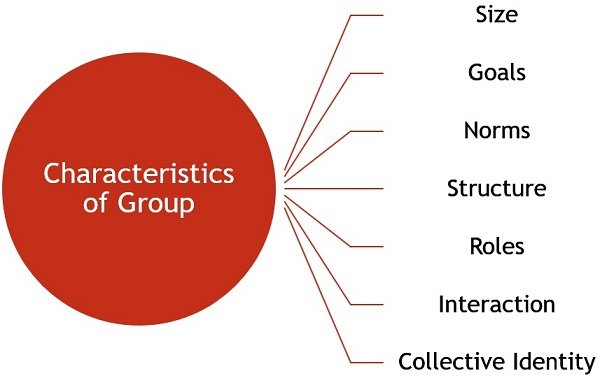Definition: A Group is basically an assemblage of people. It can be understood as a collection of individuals (two or more), who come together and interact with each other, so as to achieve the objectives of the organization. These are the foundation of an organization.
Characteristics of Groups
- Size: To form a group, it must be having at least two members. Practically, the number of group members ranges from 15 to 20. The more the members in the group, the more complex it is to manage.
- Goals: Every group has certain goals, that are the reasons for its existence.
- Norms: A group has certain rules, for interacting with the group members.
- Structure: It has a structure, based on the roles and positions held by the members.
- Roles: Every member of a group has certain roles and responsibilities, which are assigned, by the group leader.
- Interaction: The interaction between the group members can occur in several ways, i.e. face to face, telephonic, in writing or in any other manner.
- Collective Identity: A group is an aggregation of individuals, which are separately called as members, and collectively called as a group.
Furthermore, a group climate is an emotional setting of the group, that relies on participative spirit, coordination, trust and bonding among the members, open communication and other similar factors.
Types of Groups
- Formal Groups: Groups that are formed consciously by the management, with an aim of serving an organizational objective. These are further classified as:
- Self-directed teams: The group of employees which are so authorised to make decisions, on their own, as it is independent and self-governing in nature.
- Quality Circles: A number of employees classed together belonging to the same field, who meet every week for an hour, to talk about their problems, identify the causes and find out solutions, to take necessary steps in this regard.
- Committees: An association of people created by the management for different matters to identify and discuss the issues of the company and arrive at a conclusion. It can be:
- Standing Committee
- Advisory Committee
- Audit Committee
- Grievance Committee
- Adhoc Committee
- Task force: It is a temporary committee, wherein people belonging to different fields are grouped together for the performance of the task.
- Informal Groups: The social and psychological variables operating at the workplace, results in the formation of informal groups. The creation of these groups is spontaneous due to the common interest, social needs, physical proximity and mutual attraction.
Apart from the two broad classifications of the group, they are also divided into the primary groups, secondary groups, membership groups, reference groups and interest groups.
Reasons for Group Formation
- Personal Characteristics: Individuals with similar beliefs, attitudes and values are more likely to form groups.
- Opportunity for interaction: If the employees of an organization, are given an opportunity to interact with one another, they find that they have many things similar, which also creates a group.
- Interest and goals: When individuals share common interests and goals, it requires cooperation and coordination for its achievement, which also results in the formation of groups.
- Influence and power: Last but not the least, a group has more influence and power, as compared to an individual, which also promotes its formation.
In general, groups are created out of individual need satisfaction, which can be personal, social or economic. Meaning that the members need to associate with the group in order to fulfil their basic needs.




Aubrey Mashilo says
What are characteristics of group methods
Hekima kashindi says
You’re good
Hossana Nelson says
I have got what I was looking for… Thanks so much.
Traniscar Zwaoh says
Thank you so much I have found what I was searching for
Isaac says
Thank u Mr Google sir I have got what I was look thank u so much
Munmun Desai says
Too Informative, commendable work
Rakesh Verma says
Wonderful
kirsty says
who is the author?
Surbhi S says
The author of this article is Surbhi S.
Hay why says
Fabulous
Aeshwarya chauhan says
Thank you
Kamusiime diphas says
All are true
Maggie says
Thanks
Kiiza Bright says
It is a very wow explained notes hope u send me more
Emmanuel Oravbiere says
you have tried very well in your explanation.